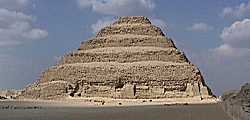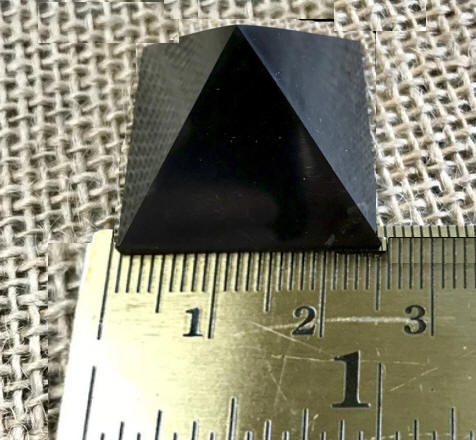|
|
||||||
|
Cheops Pyramid of Giza is the oldest and largest of three pyramids in the Giza pyramid complex bordering present-day Cairo. It is the oldest of the Seven Wonders of the Ancient World, and the only one to remain largely intact. Based on a mark in an interior chamber naming the work gang and a reference to the Fourth Dynasty. most Egyptologists believe that the pyramid was built as a tomb for king Khufu over a 10- to 20-year period concluding around 2560 BC. t is the largest pyramid in the world. There are about 110 pyramids currently known in Egypt, many in a state of great disrepair and almost unrecognizable. They were built as burial places for kings or queens. In addition, the pyramid may have represented a stairway for the king to ascend to heaven. Another possibility is that it was symbol of the primeval mound on which the sun god/creator was born. How the Egyptians managed the complex organization of labor and the moving of large stone blocks is still a matter for debate. Pyramid construction may have involved ramps being erected around the pyramid. Blocks of stone would have been pulled up on sledges and the ramps dismantled later. It is believed that most of the labour for the construction of the pyramids would have come from farmers who were available during the inundation season when the Nile River flooded and farmland was underwater. It would also have been an ideal time for the transportation by boat of large stone blocks from their quarries to the pyramid sites. |
||||||
 |
The earliest pyramid was the Step
Pyramid of king Djoser of the Old
King-dom's 3rd
Dynasty over 4600 years ago. The pyramid (to
the right)
was the largest structure ever erected at Saqqara,
the necropolis that overlooked the ancient capital of Memphis.
Its construction was initially in the form of a low mastaba tomb
upon which extra levels were gradually added to give it a step-like
appearance.
Underneath
this pyramid was a complex system of corridors with a burial
chamber lined with Aswan pink granite about 90 feet underground. was |
|||||
|
The entrance was
sealed with a three-ton granite plug. The pyramid's outside would
have been cased with fine limestone, but this was removed long ago.
Nearby were the Mortuary Temple, a Great Court and various other
structures.The first true pyramid was developed for King Sneferu during
the 4th Dynasty of the Old Kingdom. It is referred to as the Red
Pyramid,
because of its color. It is estimated that the Great Pyramid contains approximately 2.3 million blocks of stone with an average weight of 2.5 tons each and some up to 15 tons. Its sides measure 650 feet in length. The structure would have towered about 480 feet high, but it is now a little shorter owing to the outer casing having been removed to build many of Cairo's buildings during the Middle Ages. The interior design was changed during the pyramid's construction and the burial chamber was relocated.One of its most spectacular features is the enormous sloping Grand Gallery. At the Gallery's top is a low corridor which leads into the King's Chamber, the walls of which are made of polished granite. A large granite sarcophagus is open and no burial goods have ever been foundTo the east of the pyramid, some of the smooth basalt paving of the mortuary temple remains and the causeway which led to the river temple is now buried with the valley temple being under modern buildings. Small pyramids for queens are adjacent to the Great Pyramid, as are boat pits. |
||||||
| The Giza Plateau also is home to two other large pyramids for the subsequent kings, Chephrenren and Menkaura. Menkaura. As with the Great Pyramid, both of these pyramids have valley temples and mortuary temples connected by causeways. However, next to Chephren's valley temple is the famous 240-foot long Sphinx and its associated temple.Despite controversy over its age, most Egyptologists believe that the Sphinx was carved from a rocky outcrop at the same time as Chephren's pyramid. | ||||||
|
How do we find the starting point from which to calculate the prophecies in the great pyramid? If we start from the outside of the north entrance and move down the descending passage about 40 feet, we come to series of so called "scored lines". These are straight knife-edge lines cut into the blocks from roof to floor. They are on each side of the passage and directly opposite each other. Also the descending passage is in exact alignment of true north. It can be shown that in the last 5,000 years, only at one time did the north star line up exactly with the descending passage and shine directly down. This occurred in 2141 BC and the north star at that time was Draconis also called the dragon star. The northern star changes gradually over long periods of time because of the precession of the earth on its axis (like a spinning top). Also only at that time, the star cluster known as the Pleiades in the constellation Taurus was in alignment with the scored lines. Thus this is the date that pyramidologists accept as the starting date at the scored lines. Measurements in inches from the scored lines represent chronology in years. Thus we count one year for every inch we move from the scored lines, starting at 2141 BC. Now, if we move down the descending passage to the beginning of the ascending passage, we have moved a distance of 688 inches. If each inch represents one year we are at (2141 BC – 688 = 1453 BC). This year 1453 BC is accepted as the date of the exodus of the Israelites from Egypt. It symbolizes now the ascent of man towards god. If we move up the descending passage to a distance of 1485 inches, we come to the opening of the grand gallery. This year, 33 AD (1453 BC – 1485 = 33 AD) is considered to be the date of the crucifixion of Jesus Christ. If we move up the grand gallery to its end, we move 1881 inches. This year 1914 ad (33 AD – 1881 = 1914 AD), was the date of the beginning of the first world war. We can continue moving in the different passages and come up with different dates. Please refer to pyramid diagram above. Some of the pyramidologists attempted to predict future events, like the second coming of Jesus, the millennium, etc. But these events did not come to pass. It is possibly there is a chronology but the relationship is more complicated than the inch year theory. |
Pyramid inch Why did the pyramidoloigst choose the inch as the standard unit of measurement? The pyramidologists believe the linear unit used in the design of the great pyramid is the sacred cubic of 25.0265 British inches. The sacred cubit divided into 25 equal parts results in the sacred inch (also called pyramid inch) which equals 1.00106 British inches. Thus the pyramid inch is very close to our standard geometric inch. The derivation of this unit comes from measurements in the high central section of the King’s chamber passage, called the "antechamber". It has been found that the length of the antechamber is equal to the diameter of a circle having a circumference which measures as many pyramid inches as there are days in the solar year,365.242. Pyramidologists also point out that there are scientific values incorporated in the great pyramid, many not calculated or known since modern times. For example, we mentioned that the unit of measurement in the pyramid is the pyramid inch. It turns out this is the basic unit of the measurement of the earth's polar radius. Remember there are 25 pyramid inches in a sacred cubit and there are exactly 10,000,000 sacred cubits from the center of the earth to its pole. Thus the earth's polar radius is 10,000,000 sacred cubits or 250,000,000 pyramid inches exactly. |
|||||
